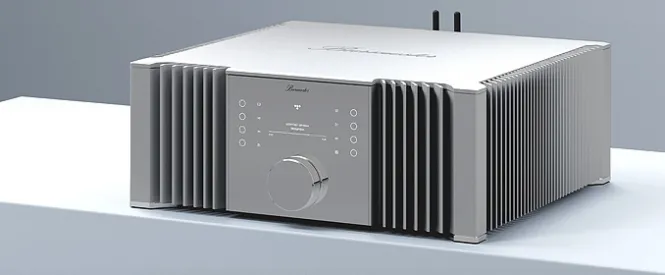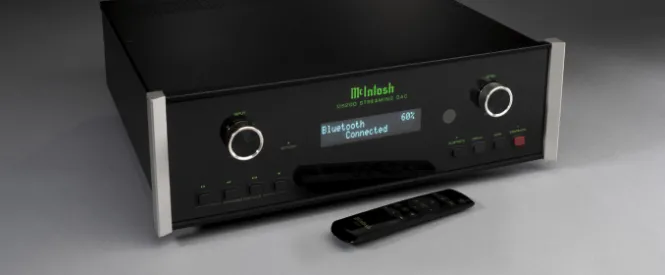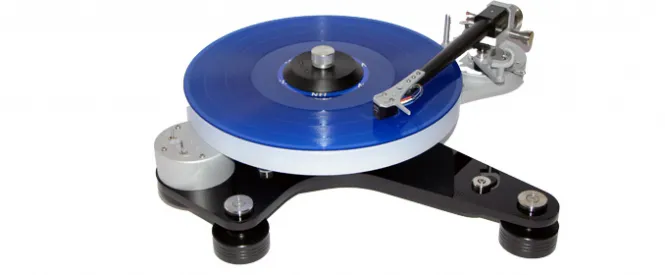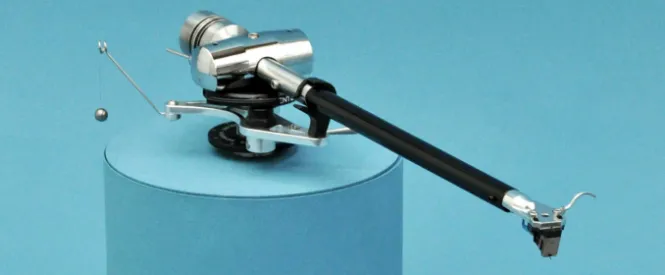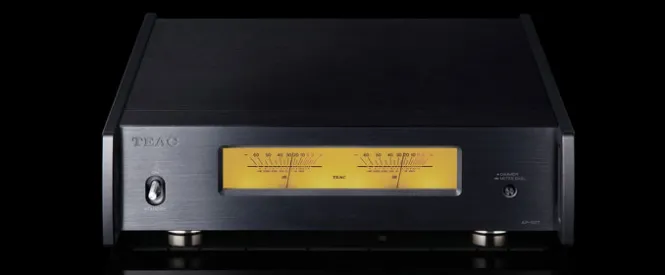Sennheiser Ambeo Max Soundbar Review
Stephen Dawson is seriously moved by this new high-end all-in-one sound system solution…
Sennheiser
AMBEO Soundbar
£2,199
When it comes to serious sound, this can’t possibly work – can it? The problem with Sennheiser’s AMBEO Soundbar is that it’s a soundbar. I love my stereo and my surround sound – but surely this isn’t either? Before you start throwing around accusations of bias, I must disclose that my favourite wireless earbuds are Sennheiser’s Momentum True Wireless 2s, while I still don my oldest over-ear headphones, Sennheiser HD 535s, which are now over twenty years old. So it’s not like I’m naturally against the brand, but can a humble soundbar really deliver the sonic goods?
Having heard the AMBEO, my answer is yes. It’s easily the best one I’ve used – and I’ve tried dozens over the years. This is the first that actually does a respectable job of producing Dolby Atmos/DTS:X surround sound without the use of separate surround speakers. Still, costing £2,199, it needs to be good. That’s twice the price of premium models from the various Korean and Japanese makers – and while its rivals come with wireless subwoofers, the Sennheiser relies entirely on its own, built-in bass drivers.
VITAL STATISTICS
This is big and heavy. It weighs 18.5kg and is 135mm tall, which is likely a touch too tall for benchtop placement with many low slung modern TVs. That height is on its feet; if you’re wall-mounting, reduce it by 10mm. It’s 1,265mm wide and 171mm deep. That’s a couple of hundred millimetres less wide than a typical 65-inch TV, and just a touch wider than a typical 55-inch TV…
Its weight is almost worryingly high – indeed it’s pretty much the same as an LG 55-inch OLED TV. Why so heavy? Perhaps it has something to do with the thirteen, yes thirteen, drivers contained therein. Let’s count them; there are six bass/midrange drivers, each 100mm in size. Plus there are five 25mm aluminium dome tweeters, plus two 89mm full-range units. More drivers than a bus depot, then! The two full-range ones are on top, angled slightly forwards to act as Dolby Atmos-enabled speakers. If you have a ceiling within reasonable range, they should do a decent job of emulating ceiling speakers. I’ve discussed this with Dolby Laboratories over the years. It isn’t simply a matter of speakers bouncing stuff off the ceiling. Some Dolby magic sauce is applied to the signal sent to these height channels to enhance the height effect.
Two of the tweeters are on the angled ends of the AMBEO, firing slightly forwards. The other three are in the expected positions, firing directly out into the room, one at the left end, one at the right and one in the middle. Between the centre tweeter and each of the outer ones are three bass midrange drivers. Yes, Sennheiser somehow managed to squeeze all thirteen drivers in. A small monochrome OLED display centred near the bottom of the soundbar provides visual feedback to the listener.
Interestingly, the enclosure appears to be sealed, with no bass reflex ports or passive radiators – and of course no subwoofer. Yet Sennheiser claims a frequency response of 30Hz to 20kHz, and not just in that vague aspirational sense so often used in measured performance but at -3dB points like proper hi-fi speakers. The manufacturer doesn’t talk much about the amplification, merely specifying it at 500W maximum.
LIVING IN A BOX
Soundbars are designed to replace home theatre speaker systems, but in a smaller form. So this needs inputs and outputs to manage other devices, such as Blu-ray players and so on. The Sennheiser is fairly well endowed with physical connections, with three HDMI inputs and one HDMI output. All are version 2.0a, which means support for UltraHD video, passing through Dolby Vision and all that good stuff. The HDMI output supports eARC – the extended version of the audio return channel, which means that the TV – if it also supports it – can feed Dolby Atmos from Netflix shows back down the wire to the AMBEO. For older TVs there’s an optical input, plus – always useful – is an analogue audio input in the form of RCA sockets.
There’s also a 2.5mm input for the classy calibration microphone. Remember, Sennheiser makes professional-grade mics as well as headphones and this soundbar. This one comes with a tall metal stand, to be positioned where you sit and at head level. The calibration system is automatic and provides the data required for the soundbar’s DSPs to do the required signal processing for – so the company says – “recreating a surround sound installation and placing you in the centre of the action.”
Not satisfied with the bass performance? There’s a subwoofer output too. When we get listening, we’ll be paying close attention to whether the Sennheiser AMBEO soundbar really does recreate a surround sound installation, and whether it can manage without a subwoofer.
It is 2020, so of course, the AMBEO supports both Bluetooth and network audio. The former includes the AAC codec in addition to the standard SBC. AAC allows better performance with iPhones and the like. Most Android phones don’t use AAC, so they’ll use the lower quality codec. Network support is via both plug-in Ethernet and Wi-Fi, with the latter being dual-band and including all standards up to 802.11ac.
Of course, the AMBEO comes with a remote control. Also provided is a one metre high-speed HDMI cable for connecting to the TV. An optional wall mount is available; at the time of writing, Sennheiser is currently bundling this – normally $99.95 – for free. You can also install Sennheiser’s Smart Control app on your phone, which works with many of the company’s Bluetooth headphones. It lets you fiddle with some of the settings, including changing the EQ should you desire, and also acts as a remote control. Unusually for this kind of thing, rather than connecting via the network, it uses Bluetooth, so your phone needs to be within about ten metres to control things.
Sorry, Apple aficionados, the AMBEO does not support Airplay – but it does do Chromecast and DLNA. The former is useful because there are many products from numerous brands that also support it, and you can group them up to make a multiroom system. Longer-term network audio users may prefer DLNA. It’s well-established, and you know precisely what data is being sent; Chromecast can be a bit obscure. There are many apps that support feeding lossless music over the network to DLNA-enabled devices. I did most of my music listening that way, using the BubbleUPnP app on my Android phone to send music from my Synology NAS. It all worked smoothly.
VIDEO STAR
The HDMI connections had no difficultly passing through UltraHD video with Dolby Vision. The AMBEO also happily decoded all the various surround audio formats on the discs I fed it, including the Dolby Atmos version of Dolby TrueHD, and the DTS equivalent, DTS:X. Naturally, it handled things like good old-fashioned Dolby Digital 5.1.
Of course, dozens of soundbars can handle Dolby Digital, and many do TrueHD and even Atmos. Yet handling merely means that they will accept the signal. Will they turn it into a convincing surround field? Well, in my experience, many bars that purport to deliver surround sound can produce a reasonably encompassing effect. That is, they tend to make sound surround you and seem as though you’re in the midst of it. What they typically can’t do is provide precise location information to your ears on elements within that sound. This is one of the ways in which the Sennheiser AMBEO is different. It produced a remarkably coherent and focused surround sound. Not just an ambient field, but specific sounds coming from specific directions.
For example, the Dolby Atmos Leaves Trailer has forest-like sounds popping out from a full hemisphere around the room, culminating in a small leaf breaking free, then spinning around audibly, from front centre up to above head-height at left rear, across to right rear, then back around to the front again. At least, that’s how it should sound with a decent Atmos-capable system with overhead speakers, and that’s how it sounds with my regular system. Incredibly, that’s also how it sounded with the AMBEO. Across the front of the room, overhead and down the sides, the location of the sound was identical to my system. Across the back, the sense of distance was not quite as great, as though the sound were just behind me – although still overhead – rather than a metre or more behind me. I didn’t expect that, and have never heard any soundbar – unaccompanied by physically separate surround speakers – produce such a convincing effect.
Next, I went for a real torture test. The ancient Video Essentials test DVD features a track of a voice circumnavigating the listening room twice, all the way around. This should proceed smoothly, without holes, jumps or variations in tone or volume. That is precisely what it did when played through the AMBEO. Again it was closer behind me than with discrete speakers, that being the only way in which it was less well done.
The action scenes in Alex Proyas’ forgettable 2016 epic, Gods of Egypt are a mass of swirling sound, filling that hemisphere in the listening room, delivered in DTS:X. This kind of thing has to be played at a high volume, so I wound up the AMBEO. Again, there was great precision in the placement of individual sound elements, but what I want to focus on is how smoothly it managed to deliver the sound even at very high levels. Soundbars typically become quite stressed when pushed this hard, but the this held it all together nicely, remaining clean and controlled. There was also plenty of slam – almost visceral in nature – when called for.
The 2007 movie Atonement, when delivered in 5.1 channel DTS-HD Master Audio, sounds superb. I’m not talking about the famous five-minute Dunkirk tracking shot, but the whole sound field – especially in the early part of the movie, with flying insects and an elegant sparseness of recording. This sounded glorious here, appearing to be coming from quality separates rather than a soundbar at the front of the room. And on all movies with substantial LFE content, something else startled me – truly deep bass, the sort that you can feel in your body. It may not have been the deepest octave that my 15-inch sub can deliver, but it sounded as though Sennheiser’s 30Hz wasn’t as silly as some might think.
MUSIC MATTERS
One of the oddities of home theatre is that surround sound seems to be more forgiving of so-so speaker performance than stereo. Play some good old-fashioned two-channel music, and the limitations of home theatre systems become all too apparent. Not so here, though. I’d say the AMBEO sounded close to a good set of stereo speakers. Not audiophile admittedly, but not bad at all. Indeed it was as though those two notional hi-fi speakers were roughly twice as far apart from each other as the width of the soundbar itself. Somehow it proved able to widen the image enormously, making for a soundstage with some sense of depth and height – although you could do better on that front with a pair of quality bookshelf-sized loudspeakers.
Detail was good because nothing was missing, and the tonal balance was very even – as you’d expect with a microphone-calibrated system. Again there was that bass; kick drums were solid, controlled and pushed the air in the room with real power. I found it hard to reconcile this bottom end performance with the driver complement. The bass guitar on Janis Joplin’s I Got Dem Ol’ Kozmic Blues Again Mama! was full and powerful. At several points through the second track – Maybe – especially a couple of minutes in, there’s some spurious noise, mostly with 50Hz and 27.6Hz components; yes, I measured it! I think someone was walking around and the underfloor space was reverberating to their footsteps. The AMBEO delivered it all, amazingly enough.
I duly put my measurement microphone up close to one of the bass/midrange drivers and had it pump out some pink noise. The reason for pushing it so close was to largely eliminate room effects, by the way. The result was ±6dB from 27.5Hz-1.76kHz. It was apparent that the output was passed to the tweeters beyond that upper frequency, and that there’s a sharp digital crossover employed, with the output dropping by 20dB in just a couple of hundred Hz.
THE VERDICT
 Sennheiser’s new AMBEO soundbar is an exceptional performer. Given that it’s so expensive you would expect it to be good, but it’s much more than this. Indeed I reckon it would be hard to come up with a 5.1.2 Dolby Atmos speaker system and receiver of equivalent performance for the price – and then, of course, there would be all that wiring and the holes in the ceiling. Granted, if two-channel stereo is your thing, then you can do better with similarly priced hi-fi separates, but it’s not as far off as you might think. So as an easy-to-install, one-box solution to deliver both music and movies, I don’t think anything currently comes close.
Sennheiser’s new AMBEO soundbar is an exceptional performer. Given that it’s so expensive you would expect it to be good, but it’s much more than this. Indeed I reckon it would be hard to come up with a 5.1.2 Dolby Atmos speaker system and receiver of equivalent performance for the price – and then, of course, there would be all that wiring and the holes in the ceiling. Granted, if two-channel stereo is your thing, then you can do better with similarly priced hi-fi separates, but it’s not as far off as you might think. So as an easy-to-install, one-box solution to deliver both music and movies, I don’t think anything currently comes close.
For more information, visit Sennheiser.
Marc Rushton
StereoNET’s Founder and Publisher was born in England and raised on British Hi-Fi before moving to Australia. He developed an early love of music and playing bass guitar before discovering the studio and the other side of the mixing desk. After writing for print magazines, Marc saw the future in digital publishing and founded the first version of StereoNET in 1999.
Posted in: Applause Awards | 2020 | Loudspeakers | Soundbars | Home Theatre
JOIN IN THE DISCUSSION
Want to share your opinion or get advice from other enthusiasts? Then head into the Message
Forums where thousands of other enthusiasts are communicating on a daily basis.
CLICK HERE FOR FREE MEMBERSHIP
Trending
applause awards
Each time StereoNET reviews a product, it is considered for an Applause Award. Winning one marks it out as a design of great quality and distinction – a special product in its class, on the grounds of either performance, value for money, or usually both.
Applause Awards are personally issued by StereoNET’s global Editor-in-Chief, David Price – who has over three decades of experience reviewing hi-fi products at the highest level – after consulting with our senior editorial team. They are not automatically given with all reviews, nor can manufacturers purchase them.
The StereoNET editorial team includes some of the world’s most experienced and respected hi-fi journalists with a vast wealth of knowledge. Some have edited popular English language hi-fi magazines, and others have been senior contributors to famous audio journals stretching back to the late 1970s. And we also employ professional IT and home theatre specialists who work at the cutting edge of today’s technology.
We believe that no other online hi-fi and home cinema resource offers such expert knowledge, so when StereoNET gives an Applause Award, it is a trustworthy hallmark of quality. Receiving such an award is the prerequisite to becoming eligible for our annual Product of the Year awards, awarded only to the finest designs in their respective categories. Buyers of hi-fi, home cinema, and headphones can be sure that a StereoNET Applause Award winner is worthy of your most serious attention.

